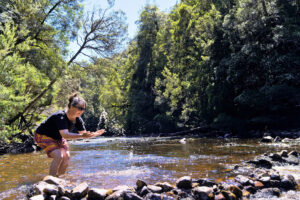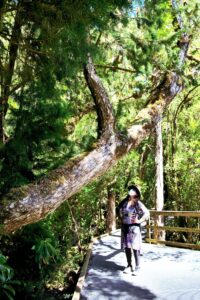
Tripping on nature
By Gabrielle Stannus
“In every walk with nature one receives far more than one seeks” John Muir, 19 July 18771. Taking a break from work to immerse yourself in nature can leave you feeling reinvigorated, and provide you with fresh design inspiration, as my partner and I found when we took a ‘little’ road trip along Tasmania’s west coast during summer.
We spent our first night camping at Macquarie Heads near Strahan, before cruising down the Gordon River on a catamaran. We then made a quick diversion to the coast (Trial Harbour), before we crossed the Pieman River by barge at Corinna to enter takayna / Tarkine, one of the last undisturbed tracts of Gondwanan rainforest in the world. From Corinna, we headed north on the famous Western Explorer Highway, an unsealed stretch of road sometimes called the ‘Road to Nowhere’. Then we set off to the ‘Edge of the World’ (Arthur River), before ending our sojourn at Stanley on the north coast.
Forest bathing
Whilst walking through the timeless landscape of takayna / Tarkine, I felt the most at ease I have in a long time. No doubt in part because I was “on holiday”. Yet, research shows that the act of “forest bathing” can be effective in reducing mental health symptoms in the short term, particularly anxiety2. Forest bathing (Shinrin-yoku) is a healing practice in Japan, where people immerse themselves in nature, while mindfully paying attention to all their senses 2,3. Forest bathing also has therapeutic effects on the immune system function, cardiovascular system, respiratory system, depression and anxiety (mood disorders and stress), mental relaxation (Attention Deficit/Hyperactivity Disorder) and human feelings of “awe”, i.e. an increase in gratitude and Selfessness.

How though can we replicate these experiences and feelings in urban public, commercial and residential landscapes, those places where we humans now spend most of our time? Where there are no ‘forests’ to ‘bathe’ in? We can connect with nature by incorporating biophilic design principles into our work, appealing to all our senses through the carefully considered use of both hard and softscape elements. 14 Patterns of Biophilic Design by Terrapin Bright Green, environmental consultants based in the United States, is an excellent resource that I refer to below, to make sense of the feelings I experienced during our journey, with a view to replicating them in our constructed environments.
Visual connection with nature
Perhaps my favourite moment of this trip was standing alone on the top deck of the catamaran whilst it was cruising slowly (5 knot speed limit!) down the Gordon River. I could feel the sun on my face and a gentle breeze on my skin, and my view to nature was essentially uninterrupted by any sign of human existence. We can obtain a visual connection with nature in our constructed landscapes when they afford us views to elements of nature, living systems and natural processes. To simulate a visual connection with nature in your landscape designs, consider including ponds, aquaria, green walls, or artwork depicting nature scenes. If possible, frame a view of a borrowed natural landscape.
Non-visual connection with nature
Arriving on the West Coast in the middle of summer, we were fortunate to experience Leatherwood (Eucryphia lucida) in full flower. Leatherwood honey is a well-known Tasmanian product, although its strong taste is not to everyone’s liking. However, the smell of its flowers in situ was much more subtly perfumed (actually I have grown to like the honey!). By appealing to auditory (sound), haptic (kinaesthetic), olfactory (smell), or gustatory (taste) stimuli, we can engender a deliberate and positive reference to nature, living systems or natural processes in our constructed landscapes. To do this, consider the use of audible and/or physically accessible water features, edible or scented plants, or highly textured fabrics/textiles that mimic natural material textures, e.g., on outdoor furniture.

(Image: Ludovic Vilbert, Inwardout Studio)
Presence of water
We spent a great deal of our time cruising, swimming, kayaking or walking along or near the rivers of the West Coast. Why are we so attracted to water in the landscape? Water’s presence in the landscape has been shown to reduce stress, increase feelings of tranquillity, and lower heart rate and blood pressure1. You can enhance the experience of a place by allowing its visitors to see, hear and/or touch water, e.g. ponds, fountains, water falls or walls, aquariums or streams.
Mystery
Who could resist the lure of the evocatively named “Lovers Falls”? To get there though, required a one-hour kayak trip down the Pieman River. To find this spot, we were told to look out for a small buoy on the right-hand side of the river as we headed downstream. Just near that buoy we found a mysterious stairway leading from the river into the rainforest. We were compelled to enter this space and so lured into this magnificent environment. The promise of more information achieved through partially obscured views or other sensory devices entices the individual to travel deeper into the environment1. You can achieve a similar effect in your landscapes by incorporating winding paths or auditory stimulation hidden from immediate sight, e.g., a water feature.

Gabrielle Stannus, Inwardout Studio)
Risk/Peril
I have a very healthy respect for heights (code for fear!), so entering this suspension bridge over the Avon Creek near Montezuma Falls was about as much risk as I was willing to take on this occasion. There is very little danger of anyone getting hurt or falling from this well-constructed bridge. However, I could not bring myself to cross this bridge, yet other walkers merrily traipsed their way over it. One French tourist practically danced her way across this bridge! When introducing risk into a designed landscape, the risk does not have to be ‘real’, just perceived, e.g., falling, getting wet, getting hurt or loss of control. Depending on the setting, you may include only a lower-level risk, e.g., getting your feet wet as opposed to potentially falling into the water. To introduce risk into your landscape, encourage its users to pass under, over or through water. Also consider features such as cantilevers, infinity edges, transparent railings, or even proximity to an active honeybee apiary.

(Image: Ludovic Vilbert, Inwardout Studio)
Material connection with nature
According to Terrapin, the use of material and elements from nature that reflect the local ecology or geology can help to create a distinct sense of place. The rainforests of western and southern Tasmania are home to unique vegetation found nowhere else in the world, including Gondwanan relicts such as the Huon Pine (Lagarostrobos franklinii). Most seen along rivers such as the Gordon and Pieman, the Huon Pine grows at low to moderate altitudes, but occasionally extends into the alpine zone. Its wood is good for furniture and boat building, and its drooping branches and fine weeping scale-like foliage make it a great specimen for a rainforest garden or container. However, Huon Pine is both very slow-growing and fire sensitive, growing only in fire-free areas, and its distribution has decreased due to logging4. When choosing ‘natural’ materials such as this timber, make sure it is not just ‘legal’ but ethically sourced. As landscape and horticultural professionals, we have a duty of care when selecting materials to ensure they have minimal environmental impact.
Take the green (not brown) trip!
As Australia opens its borders, why not take a well-deserved break away from the hustle and bustle of our urban environments? Your mental and physical well-being will thank you for it, and your designs and therefore your clients may just benefit as well.
Gabrielle Stannus
Inwardout Studio
M: 0400 431 277
E: gabrielle@inwardoutstudio.com
References
- Terrapin Bright Green 2014, 14 Patterns of Biophilic Design (pages 4, 12 & 49)
- Kotera, Y, Richardson, M & Sheffield, D 2020, ‘Effects of Shinrin-Yoku (Forest Bathing) and Nature Therapy on Mental Health: a Systematic Review and Meta-analysis’, International Journal of Mental Health and Addiction, 28 July 2020
- Hansen, MM, Jones, R & Tocchini, K 2017, ‘Shinrin-Yoku (Forest Bathing) and Nature Therapy: A State-of-the-Art Review’, International Journal of Environmental Research and Public Health, 14(8): 851
- University of Tasmania 2019, ‘Lagarostrobos franklinii’, Key to Tasmanian Vascular Plants, viewed 7 February 2022, https://www.utas.edu.au/dicotkey/dicotkey/CONIFERS/sLagarostrobos.htm
